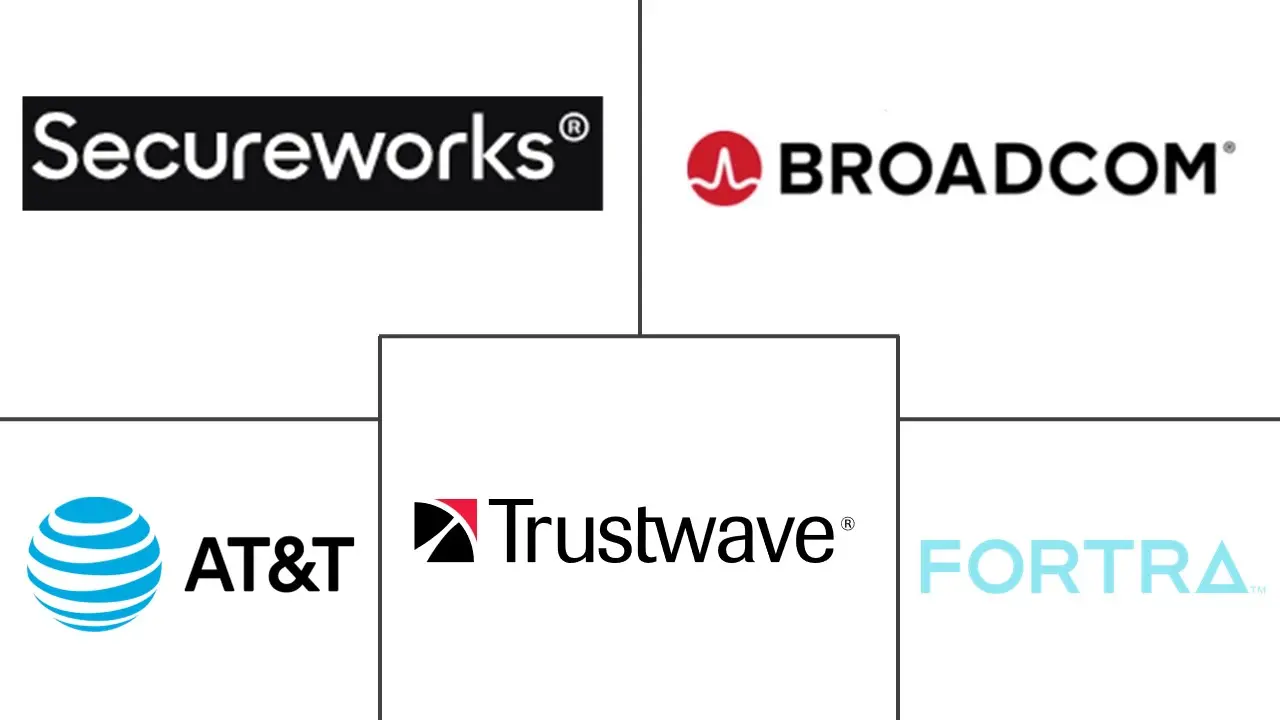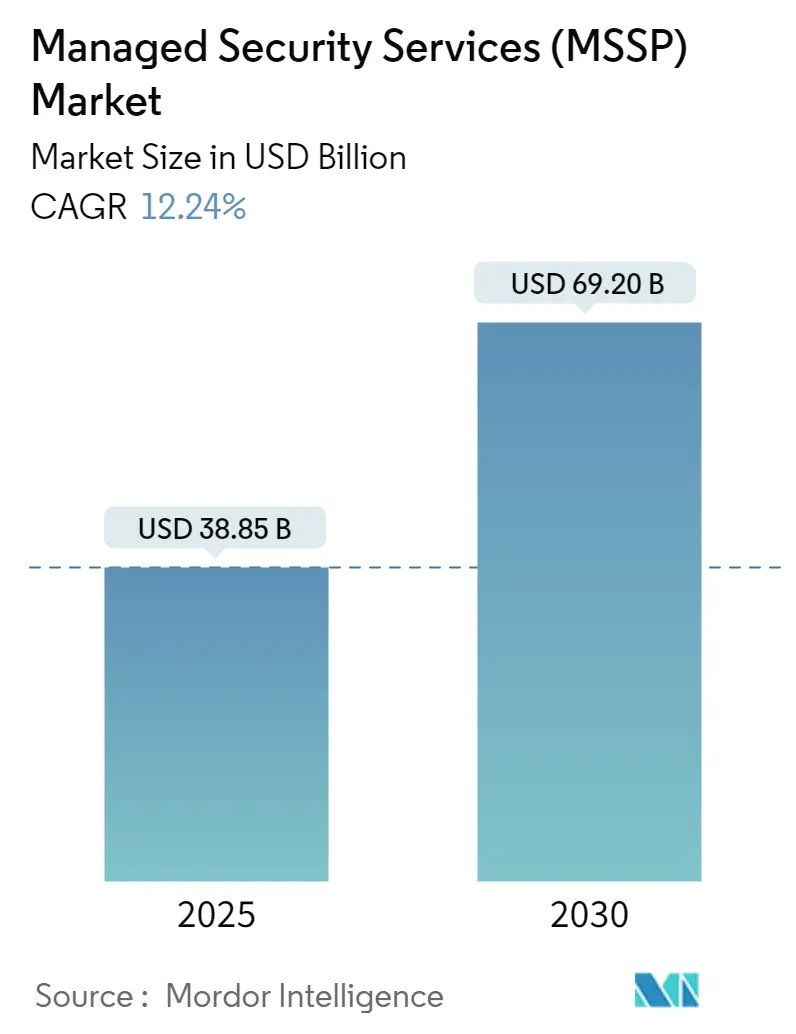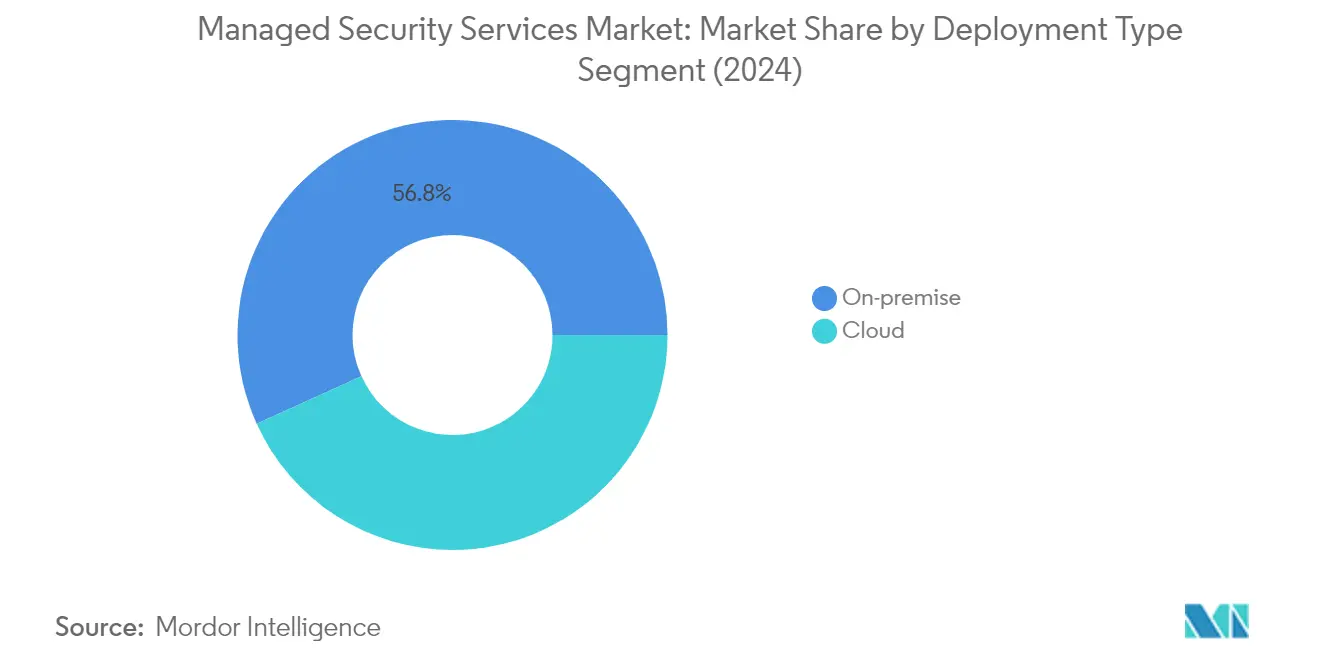Managed Security Services (MSSP) Market Analysis
The Managed Security Services Market size is estimated at USD 38.85 billion in 2025, and is expected to reach USD 69.20 billion by 2030, at a CAGR of 12.24% during the forecast period (2025-2030).
The managed security services landscape is experiencing a profound transformation driven by the increasing sophistication of cyber threats and the evolution of enterprise IT infrastructure. According to IBM's latest findings, the average total cost of a data breach reached USD 4.45 million in 2023, highlighting the escalating financial implications of security incidents. Organizations are increasingly turning to managed security services providers (MSSPs) to navigate the complex security landscape, as traditional in-house security solutions struggle to keep pace with emerging non-file-based threats and advanced persistent threats (APTs). The convergence of IT service providers and MSSPs has created a new paradigm where providers offer comprehensive suites of both IT and security solutions, streamlining vendor management and enhancing overall protection.
The financial services sector has emerged as a critical battleground for cybersecurity, with threat actors deploying increasingly sophisticated attack vectors. In 2023, the banking malware landscape witnessed unprecedented complexity, with Godfather malware alone spawning 1,171 known variants, while Nexus malware led the pack with approximately 500 variants. Financial institutions are responding by implementing advanced real-time security monitoring services, including endpoint detection and response (EDR), biometric technology, and integrated security solutions. The sector's adoption of cloud-based services and digital transformation initiatives has created new attack surfaces, necessitating more robust and comprehensive security frameworks.
The integration of emerging technologies like artificial intelligence, machine learning, and automation is revolutionizing the managed security services space. MSSPs are leveraging these technologies to enhance threat detection capabilities, automate security operations, and accelerate incident response times. The trend toward cloud-based security solutions continues to gain momentum, with providers offering scalable, flexible platforms that can adapt to evolving threat landscapes. This technological evolution is particularly evident in the development of advanced Security Operations Centers (SOCs) that combine human expertise with AI-driven analytics to provide 24/7 threat monitoring and response capabilities.
The regulatory landscape and compliance requirements are becoming increasingly complex, driving organizations to seek specialized expertise through managed security services. Annual data compromises in the United States have seen a dramatic increase, rising from 1,108 in 2020 to 3,205 in 2023, underscoring the growing need for robust security measures. MSSPs are responding by expanding their service portfolios to include compliance monitoring, risk assessment, and regulatory reporting capabilities. The trend toward industry-specific security solutions is gaining traction, with providers developing tailored services that address the unique security challenges faced by different sectors while ensuring compliance with relevant regulatory frameworks.
Managed Security Services (MSSP) Market Trends
Rising Cybercrime, Digital Disruption, and Increased Compliance Demands
The global digitalization trend has created unprecedented opportunities for cybercriminals to exploit vulnerabilities in online systems, networks, and infrastructure, leading to significant economic and social repercussions for governments, businesses, and individuals worldwide. As organizations embrace digital transformation, adopting technologies like cloud computing, AI, IoT, and big data analytics, the cybersecurity landscape is rapidly evolving. This shift exposes businesses to new and ever-changing cybersecurity threats, particularly as critical infrastructure becomes more interconnected and reliant on digital platforms.
The integration of digital technologies into critical infrastructure, such as energy grids, transportation systems, and healthcare facilities, has amplified the potential damages from cyberattacks. The managed security services market trends are witnessing significant shifts driven by the convergence of security intelligence and digital transformation technologies. Real-time threat monitoring has become crucial, enabling firms to proactively identify and address cyber threats. Security intelligence platforms now leverage advanced analytics and machine learning algorithms to counter Advanced Persistent Threats (APTs) known for their stealthy nature.
Need for Threat Detection and Intelligence at an Early Stage Driving the Market Growth
The digital transformation era has fueled an unprecedented expansion of data-intensive applications and technologies, resulting in a significant surge in the volume, velocity, and variety of data generated and processed by businesses. As organizations harness the potential of big data, artificial intelligence, and machine learning, securing this valuable asset becomes paramount. With the growing reliance on data-intensive approaches, organizations must manage large datasets containing sensitive information, underscoring the need for robust cybersecurity measures.
Data, being a critical asset for modern businesses, has become a prime target for cyber adversaries, driving the need for enhanced security. Cybercriminals persistently exploit data security weaknesses, aiming to compromise confidentiality, integrity, and availability. The interconnectedness of data-intensive systems, spanning cloud environments, edge computing, and on-premises infrastructure, demands a holistic cybersecurity approach. Organizations are increasingly investing in advanced cybersecurity services that seamlessly integrate with complex data architectures, providing protection across diverse platforms. According to IBM, the cost per stolen record in global data breaches reached USD 165 in 2023, highlighting the financial implications of inadequate data protection measures.
Segment Analysis: By Deployment Type
On-premise Segment in Managed Security Services Market
The on-premise deployment segment continues to dominate the managed security services market, commanding approximately 57% market share in 2024. This significant market position is attributed to several key factors, including the growing emphasis on security and compliance, heightened focus on data privacy and confidentiality, considerations around legacy infrastructure, and perceived performance advantages. Organizations, particularly in highly regulated industries, prefer on-premise solutions for their ability to maintain greater control over sensitive data and provide superior threat protection compared to cloud alternatives. The deployment of on-premise solutions requires a skilled workforce and substantial resources, making them particularly attractive to large enterprises with established IT infrastructure. These solutions offer high levels of customization to align with specific organizational processes and regulatory requirements, while also providing cost advantages through the elimination of monthly expenses in favor of annual or multi-layer plans.
Cloud Segment in Managed Security Services Market
The cloud deployment segment is experiencing remarkable growth in the managed security services market, projected to expand at approximately 14% CAGR from 2024 to 2029. This accelerated growth is driven by various factors, including scalability, flexibility, centralized platforms, ease of accessibility, and cost-effectiveness. The increasing adoption of cloud security services is further fueled by the growing reliance on remote and mobile capabilities by the global workforce. Cloud-based managed security services enable service providers to access, monitor, and remotely resolve issues within the cloud environment, ensuring quick and efficient problem resolution. The segment's growth is additionally supported by the increasing penetration of emerging technologies such as AI/ML, big data analytics, threat intelligence, and advanced automation platforms. Organizations are increasingly realizing the benefits of saving money and resources by migrating their data to the cloud rather than constructing and maintaining new data storage infrastructure.
Segment Analysis: By Solution Type
Threat Prevention Segment in Managed Security Services Market
The threat prevention segment continues to dominate the managed security services market, commanding approximately 29% market share in 2024. This segment's prominence is driven by the increasing sophistication of cyber threats and the growing need for advanced threat protection solutions. Organizations are increasingly adopting threat prevention services to safeguard against malware, ransomware, and emerging threats via email spam and phishing. The segment's leadership position is further strengthened by the integration of artificial intelligence and machine learning capabilities in threat prevention solutions, enabling more effective detection and response to sophisticated cyberattacks. Major vendors are continuously enhancing their threat prevention offerings with features like automated alert management, round-the-clock monitoring, and advanced threat intelligence capabilities to maintain their competitive edge in this crucial market segment.
Intrusion Detection and Prevention Segment in Managed Security Services Market
The intrusion detection and prevention segment is emerging as the fastest-growing segment in the managed security services market, projected to grow at approximately 14% CAGR from 2024 to 2029. This remarkable growth is driven by the increasing complexity of cyberattacks and evolving regulatory requirements mandating the implementation of IDS and IPS systems. Organizations are increasingly recognizing the value of proactive cybersecurity approaches, leading to higher adoption of automated security monitoring tools. The segment's growth is further accelerated by the integration of advanced technologies like artificial intelligence and machine learning in IDS/IPS solutions, enabling more sophisticated threat detection capabilities. Recent innovations in this space include enhanced virtual intrusion prevention systems and improved traffic-handling capabilities, particularly in cloud environments.
Remaining Segments in Solution Type
The managed security services market encompasses several other vital segments, including risk assessment, endpoint security services, distributed denial of services (DDoS), and managed firewall services. Risk assessment services play a crucial role in evaluating and mitigating organizational security risks, while endpoint security services have gained significance with the rise of remote work and BYOD policies. DDoS protection services have become increasingly important for maintaining business continuity and preventing service disruptions, particularly for online-dependent organizations. Managed firewall services continue to provide essential perimeter security and network protection, adapting to evolving network architectures and cloud environments. Each of these segments contributes uniquely to the comprehensive security posture of organizations, addressing specific aspects of the modern threat landscape.
Segment Analysis: By Managed Security Service Provider
IT Service Providers Segment in Managed Security Services Market
IT Service Providers dominate the managed security services market, commanding approximately 59% market share in 2024. This significant market presence can be attributed to enterprises increasingly turning to managed services as they grapple with overseeing multiple advanced software systems and complex enterprise networks. Organizations are particularly focused on outsourcing cyber defenses to safeguard their digital assets from evolving security threats. These providers offer comprehensive outsourced security solutions, encompassing continuous monitoring, on-demand IT support, and issue resolution. Their services extend beyond traditional IT offerings, providing additional resources like IT implementation and security consulting services. The segment's strength is further reinforced by the growing adoption of cloud security services, supported by rising collaborations among prominent IT service companies, including industry leaders like Accenture, TCS, and Infosys, who are actively expanding their cloud security services portfolios to facilitate digital transformation across various end-user industries.
Telecom Service Providers Segment in Managed Security Services Market
The Telecom Service Providers segment is emerging as the fastest-growing segment in the managed security services market, projected to grow at approximately 13% CAGR from 2024 to 2029. This remarkable growth is driven by telecom firms either acquiring security companies to enter the managed security services sector or bolstering their existing strategies. The telecom industry is witnessing transformative changes, driven by escalating bandwidth demands and digital transformations, including cloud adoption. This industry evolution positions communication service providers uniquely to offer both communication and network security services. Major telecom players are diversifying their offerings, expanding their portfolio of managed security services, enabling them to extend outsourced security services to their existing business clientele. The segment's growth is further supported by the increasing emphasis on network security services and the rising demand for integrated communication and security solutions across various industries.
Remaining Segments in Managed Security Service Provider
The Managed Security Specialist segment plays a crucial role in the overall managed security services market landscape. These specialists bring focused expertise in areas such as vulnerability testing, digital forensics, and risk monitoring. They are particularly vital in serving specific industry verticals like financial services and healthcare, where specialized security knowledge and compliance expertise are essential. These providers act as a nexus, bringing together people, processes, and technologies to help organizations achieve their security goals. Their services are particularly valuable for organizations requiring deep security expertise and customized solutions, complementing the broader service offerings of IT service providers and telecom companies while maintaining a dedicated focus on security-specific challenges and solutions.
Segment Analysis: By End-User Industry
IT & Telecom Segment in Managed Security Services Market
The IT & Telecom sector dominates the managed security services market, commanding approximately 25% market share in 2024. This dominance can be attributed to the sector's increasing adoption of managed services across various applications, including managed security, managed networks, managed data centers, and IT infrastructure. The emergence of technologies such as AI, ML, and analytics has further fueled the adoption of managed security services in this sector. As telecom operators transition from being solely network companies to becoming cloud service providers, they face heightened risks of data breaches that could impact not only the companies themselves but also their third-party providers and subscribers. The managed security services and IT infrastructure segment maintains a prominent market position, driven by the growing need to integrate complex IT infrastructure and digitization. Additionally, the Internet of Things (IoT) expansion has created new vulnerabilities for malware attacks, making managed security services crucial for maintaining business resilience against potential cyberattacks involving IoT devices.
BFSI Segment in Managed Security Services Market
The BFSI sector is emerging as the fastest-growing segment in the managed security services market, with a projected growth rate of approximately 14% during 2024-2029. This remarkable growth is driven by the sector's rapid digitization, particularly in the realm of digital banking and online payments, which has intensified the need for robust managed security services. Financial institutions worldwide are enhancing their cyber threat prevention strategies, recognizing the critical importance of safeguarding sensitive client data and fortifying overall security infrastructure. The sector's growth is further propelled by the implementation of round-the-clock monitoring capabilities, enabling swift incident response and remediation in case of breaches. The increasing adoption of advanced real-time security measures, including endpoint detection and response (EDR), biometric technology, cloud security, and integrated security solutions, demonstrates the sector's commitment to strengthening its cybersecurity posture. Moreover, regulatory compliance requirements and the need for proactive threat intelligence have made managed security services indispensable for BFSI organizations.
Remaining Segments in End-User Industry
The managed security services market encompasses several other significant sectors beyond IT & Telecom and BFSI. The Government and Defense sector emphasizes high standards for security certification and technology, particularly in protecting critical infrastructure and sensitive data. The Manufacturing sector focuses on safeguarding industrial IoT implementations and protecting intellectual property through comprehensive security solutions. The Healthcare and Life Sciences sector prioritizes patient data protection and compliance with regulatory requirements, while the Retail sector addresses the growing concerns of e-commerce security and customer data protection. These segments collectively contribute to the market's diverse landscape, each bringing unique security requirements and challenges that drive innovation in managed security services. The varying needs across these sectors have led to the development of specialized security solutions and services, fostering a robust and dynamic market environment.
Managed Security Services Market Geography Segment Analysis
Managed Security Services Market in North America
North America continues to dominate the global managed security services market, commanding approximately 40% of the total market share for managed security services in 2024. The region's leadership position is primarily driven by the concentration of major technology firms and the heightened cyber threat landscape in its developed economies. The United States, in particular, faces an increasingly sophisticated cyber threat environment, given its advanced digital and cloud infrastructure, making it a prime target for cybercrime globally. The surge in cloud security solutions adoption is particularly notable in the U.S. as organizations increasingly rely on cloud computing for data storage, application hosting, and core operations. This shift necessitates robust security measures to safeguard sensitive data and ensure the integrity of cloud-based applications. Advanced threat detection and response capabilities, often powered by AI and machine learning, have become integral to these cloud security solutions. The region's market growth is further bolstered by the rapid integration of emerging technologies and the increasing adoption of managed security services across various industry verticals.
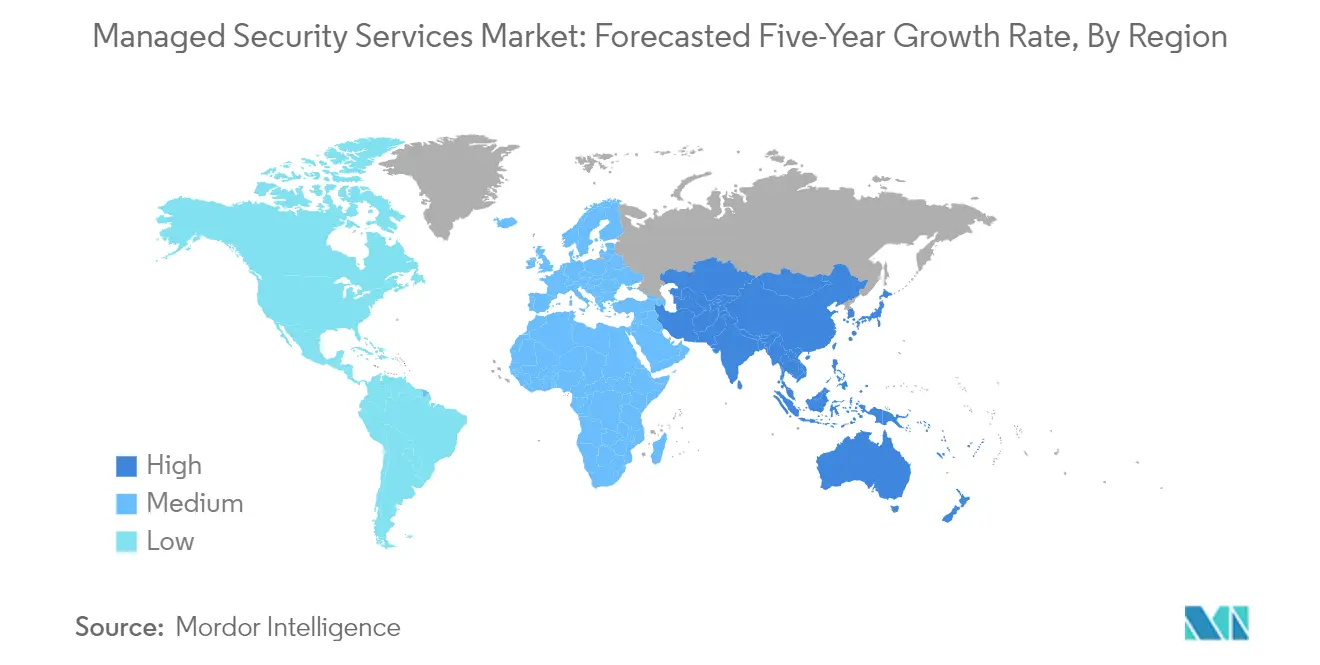
Managed Security Services Market in Europe
Europe has demonstrated remarkable growth in the managed security services market from 2019 to 2024, driven by the increasing complexity of cyber threats and stringent regulatory requirements. Service providers in the region are establishing managed security operations centers (SOCs) to deliver comprehensive security and support services. Most providers deploy their own unified security management platforms for customers, providing security information, event management, and other monitoring solutions. The European market's evolution is characterized by the growing adoption of advanced technologies and the increasing focus on compliance with data protection regulations like GDPR. Organizations across Europe, regardless of their size, are increasingly relying on managed service providers to ensure technology usage transforms and scales their businesses effectively. The market has witnessed significant expansion through strategic partnerships and service portfolio diversification, with providers adding value through expertise, innovative solutions, and competitive pricing models.
Managed Security Services Market in Asia-Pacific
The Asia-Pacific managed security services market is poised for exceptional growth, with a projected CAGR of 17.42% during 2024-2029. The region's market dynamics are shaped by increasing cybersecurity threats, including IT ransomware attacks, DDoS attacks, and data exfiltration incidents. The rapid development of AI, 5G, IoT, virtual reality, and their commercial applications is driving unprecedented demand for data processing and information interaction. This technological evolution has accelerated the construction of data centers and led to explosive industry growth. Organizations in the region are prioritizing standardized information security models based on business risk approaches, focusing on establishing, implementing, operating, monitoring, reviewing, maintaining, and improving overall information security for customers. The market is further strengthened by extensive government initiatives, increasing digital transformation across various sectors, and growing awareness of cybersecurity importance among enterprises.
Managed Security Services Market in Latin America
The Latin American managed security services market is experiencing significant transformation, driven by the digital infrastructure development in key countries like Brazil, Argentina, and Mexico. The region's growth is characterized by increasing adoption of online business strategies to support economic development, which consequently drives the need for robust cybersecurity measures. The market is witnessing substantial investments in IT infrastructure protection, particularly in response to the rising sophistication of cyber threats targeting emerging digital economies. Organizations across various sectors are increasingly recognizing the importance of implementing comprehensive managed security solutions to protect their digital assets and ensure business continuity. The region's market dynamics are further influenced by government initiatives to strengthen cybersecurity frameworks and the growing awareness of cyber threats among enterprises.
Managed Security Services Market in Middle East & Africa
The Middle East & Africa region is emerging as a significant market for managed security services, driven by the rising number of security breaches and sophisticated cyberattacks across regional enterprises. The financial services and government sectors are leading the adoption of managed security solutions in the region. Countries in the Gulf region, particularly Saudi Arabia, are making substantial investments in cybersecurity infrastructure as part of their digital transformation initiatives. The focus areas include smart grid implementation, geospatial IT systems, and critical infrastructure protection. Businesses across the region are implementing ambitious transformation roadmaps to ensure their relevance in the digital world, with the adoption of third-platform technologies such as cloud, mobility, and social becoming mainstream. The market is further strengthened by increasing awareness of cybersecurity importance and the growing need for specialized security services across various industry verticals.
Managed Security Services (MSSP) Market Overview
Top Companies in Managed Security Services Market
The managed security services provider market features prominent players, including IBM Corporation, AT&T, Verizon, Secureworks, Broadcom, and other global technology leaders. These managed security services companies are actively pursuing product innovation through the integration of artificial intelligence, machine learning, and advanced analytics into their security offerings to enhance threat detection and response capabilities. Operational agility is being achieved through the establishment of global security operations centers providing round-the-clock monitoring and incident response services. Strategic moves in the market are characterized by an increasing focus on cloud-based security solutions and the development of industry-specific security offerings. Companies are expanding their geographical presence through strategic partnerships with local providers and establishing regional security operations centers to better serve diverse market needs. The emphasis on developing comprehensive end-to-end security solutions, from threat detection to incident response and recovery, demonstrates the market's evolution towards more integrated service offerings.
Market Dominated by Global Tech Giants
The managed security services market exhibits a structure dominated by large global technology conglomerates and telecommunications providers, who leverage their extensive infrastructure and technological capabilities to deliver comprehensive security solutions. These established players benefit from their broad customer base, strong brand recognition, and ability to offer integrated solutions across multiple technology domains. The market also includes specialized security service providers who compete through deep expertise in specific security domains or industry verticals. Market consolidation is increasingly evident as larger players acquire specialized security firms to enhance their capabilities and expand their service portfolios.
The competitive landscape is characterized by strategic partnerships between technology providers, telecommunications companies, and cybersecurity specialists to create more comprehensive security offerings. Major players are actively pursuing mergers and acquisitions to strengthen their market position, acquire new technologies, and expand their geographical presence. This consolidation trend is particularly pronounced in emerging markets where local expertise and regulatory knowledge are crucial for market success. The market structure is evolving with the entry of cloud service providers and managed service providers who are expanding their security capabilities to meet growing customer demands for integrated security solutions.
Innovation and Adaptability Drive Market Success
For incumbent players to maintain and increase their market share, the focus must be on continuous innovation in security technologies, particularly in areas such as artificial intelligence, machine learning, and automation. These companies need to strengthen their consulting capabilities to help clients navigate complex security challenges and regulatory requirements. Developing industry-specific solutions, expanding global delivery capabilities, and maintaining strong partnerships with technology providers are crucial strategies. Additionally, incumbents must invest in talent development and retention to ensure they have the expertise needed to address evolving security threats.
For contenders looking to gain ground in the market, success lies in identifying and focusing on specific market niches or industry verticals where they can build deep expertise. These companies need to develop innovative service delivery models that can compete with established players while maintaining cost-effectiveness. Building strong relationships with end-users through superior customer service and flexible engagement models is essential. The ability to adapt quickly to changing regulatory requirements and emerging security threats while maintaining compliance with industry standards will be crucial for long-term success. Companies must also consider the impact of increasing end-user concentration in certain sectors and develop strategies to address the risk of service commoditization.
Managed Security Services (MSSP) Market Leaders
-
AT&T Inc.
-
Secureworks Corp.
-
Broadcom Inc.
-
Trustwave Holdings, Inc. (the Chertoff Group)
-
Fortra, Llc
- *Disclaimer: Major Players sorted in no particular order
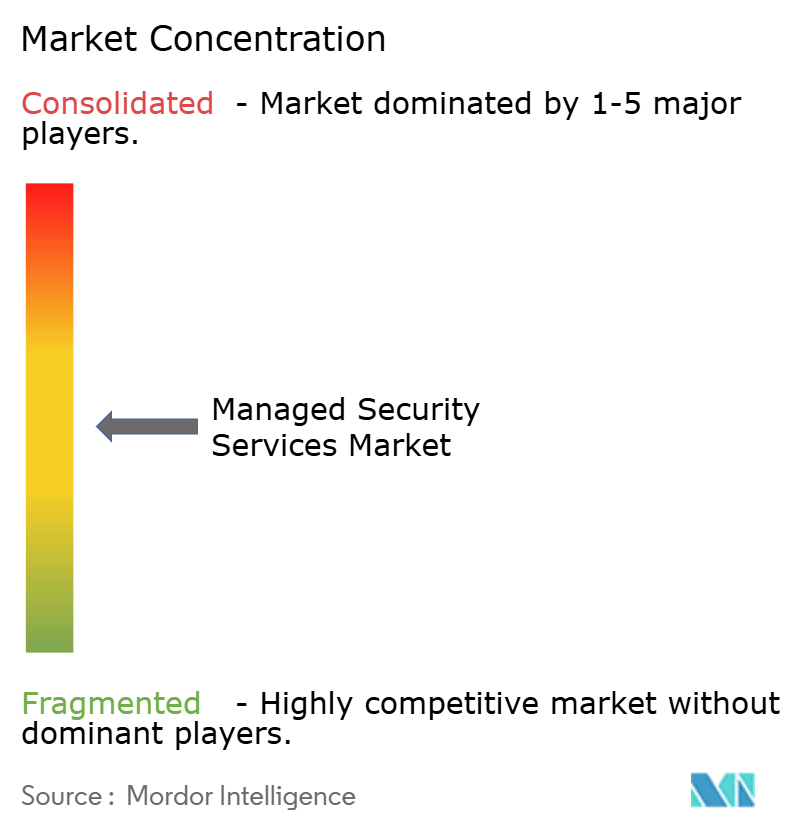
Managed Security Services (MSSP) Market News
- June 2024: Ontinue, an AI-driven provider of managed extended detection and response (MXDR) services, has forged a strategic alliance with Oxfam. Oxfam, a renowned global non-profit, is dedicated to combating inequality and striving to eradicate poverty and injustice. By partnering with Ontinue, Oxfam aims to bolster its cybersecurity measures. This collaboration promises enhanced efficiencies, round-the-clock protection, quicker response times, and an optimized utilization of Oxfam's existing Microsoft Security investments. Given their mission, non-profits like Oxfam often manage sensitive data, including donor information, financial records, and millions of personal details of those they assist.
- March 2024: BT and Zscaler have expanded their partnership, making BT the first global service provider to offer a comprehensive suite of managed security services. These services are built on Zscaler's AI-driven Zero Trust Exchange cloud security platform. With this collaboration, BT can now provide its customers with innovative solutions that simplify IT infrastructures and reduce cyber-attack vulnerability. This empowers businesses to be more agile, efficient, resilient, and secure. Additionally, Zscaler will furnish BT Group with security solutions to safeguard its operations. This move bolsters BT's security and enriches its expertise in assisting customers with Zscaler's offerings.
Managed Security Services (MSSP) Market Report - Table of Contents
1. INTRODUCTION
- 1.1 Study Assumptions and Market Definition
- 1.2 Scope of the Study
2. RESEARCH METHODOLOGY
3. EXECUTIVE SUMMARY
4. MARKET INSIGHTS
- 4.1 Market Overview
-
4.2 Industry Attractiveness - Porter's Five Forces Analysis
- 4.2.1 Bargaining Power of Suppliers
- 4.2.2 Bargaining Power of Buyers
- 4.2.3 Threat of New Entrants
- 4.2.4 Intensity of Competitive Rivalry
- 4.2.5 Threat of Substitutes
5. MARKET DYNAMICS
-
5.1 Market Drivers
- 5.1.1 Rising Cyber Crime, Digital Disruption, and Increased Compliance Demands
- 5.1.2 Need for Threat Detection and Intelligence at an Early Stage Driving the Market Growth
-
5.2 Market Restraints
- 5.2.1 Lack of Awareness of Security Services is Discouraging the Market Expansion
- 5.3 Evolution and Key Trends in the MSSP Space
- 5.4 Impact of COVID-19 on the Market
6. MARKET SEGMENTATION
-
6.1 By Deployment Type
- 6.1.1 On-premise
- 6.1.2 Cloud
-
6.2 By Solution Type
- 6.2.1 Intrusion Detection and Prevention
- 6.2.2 Threat Prevention
- 6.2.3 Distributed Denial of Services
- 6.2.4 Firewall Management
- 6.2.5 End-point Security
- 6.2.6 Risk Assessment
-
6.3 By Managed Security Service Provider
- 6.3.1 IT Service Providers
- 6.3.2 Managed Security Specialist
- 6.3.3 Telecom Service Provider
-
6.4 By End-user Industry
- 6.4.1 BFSI
- 6.4.2 Government and Defense
- 6.4.3 Retail
- 6.4.4 Manufacturing
- 6.4.5 Healthcare and Life Sciences
- 6.4.6 IT and Telecom
- 6.4.7 Other End-user Verticals
-
6.5 By Geography***
- 6.5.1 North America
- 6.5.2 Europe
- 6.5.3 Asia
- 6.5.4 Australia and New Zealand
- 6.5.5 Latin America
- 6.5.6 Middle East and Africa
7. COMPETITIVE LANDSCAPE
-
7.1 Company Profiles
- 7.1.1 AT&T Inc.
- 7.1.2 Secureworks Corp.
- 7.1.3 Broadcom Inc.
- 7.1.4 Trustwave Holdings Inc. (the Chertoff Group)
- 7.1.5 Fortra LLC
- 7.1.6 IBM Corporation
- 7.1.7 Verizon Communications Inc.
- 7.1.8 Lumen Technologies Inc.
- 7.1.9 BAE Systems PLC
- 7.1.10 Atos SE
- 7.1.11 Capgemini SE
- 7.1.12 Wipro Limited
- 7.1.13 Fujitsu Limited (Fujitsu Group)
- *List Not Exhaustive
8. VENDOR POSITIONING ANALYSIS
9. INVESTMENT ANALYSIS AND MARKET OUTLOOK
Managed Security Services (MSSP) Market Industry Segmentation
The managed security service market is defined by the revenues generated from diverse solutions used across various industries worldwide. The analysis draws from both primary and secondary research, capturing market insights. It delves into the key drivers and restraints shaping the market's growth.
The managed security services market is segmented by deployment type (on-premise and cloud), by solution type (intrusion detection and prevention, threat prevention, distributed denial of services, firewall management, end-point security, and risk assessment), by managed security service provider (IT service providers, managed security specialist, and telecom service provider), by end-user industry (BFSI, government and defense, retail, manufacturing, healthcare and life sciences, IT and telecom, and other end-user verticals), and by geography (North America, Europe, Asia Pacific, Latin America, and Middle East and Africa). The report offers market forecasts and size in value (USD) for all the above segments.
| By Deployment Type | On-premise |
| Cloud | |
| By Solution Type | Intrusion Detection and Prevention |
| Threat Prevention | |
| Distributed Denial of Services | |
| Firewall Management | |
| End-point Security | |
| Risk Assessment | |
| By Managed Security Service Provider | IT Service Providers |
| Managed Security Specialist | |
| Telecom Service Provider | |
| By End-user Industry | BFSI |
| Government and Defense | |
| Retail | |
| Manufacturing | |
| Healthcare and Life Sciences | |
| IT and Telecom | |
| Other End-user Verticals | |
| By Geography*** | North America |
| Europe | |
| Asia | |
| Australia and New Zealand | |
| Latin America | |
| Middle East and Africa |
Managed Security Services (MSSP) Market Research FAQs
How big is the Managed Security Services Market?
The Managed Security Services Market size is expected to reach USD 38.85 billion in 2025 and grow at a CAGR of 12.24% to reach USD 69.20 billion by 2030.
What is the current Managed Security Services Market size?
In 2025, the Managed Security Services Market size is expected to reach USD 38.85 billion.
Who are the key players in Managed Security Services Market?
AT&T Inc., Secureworks Corp., Broadcom Inc., Trustwave Holdings, Inc. (the Chertoff Group) and Fortra, Llc are the major companies operating in the Managed Security Services Market.
Which is the fastest growing region in Managed Security Services Market?
Asia Pacific is estimated to grow at the highest CAGR over the forecast period (2025-2030).
Which region has the biggest share in Managed Security Services Market?
In 2025, the North America accounts for the largest market share in Managed Security Services Market.
What years does this Managed Security Services Market cover, and what was the market size in 2024?
In 2024, the Managed Security Services Market size was estimated at USD 34.09 billion. The report covers the Managed Security Services Market historical market size for years: 2019, 2020, 2021, 2022, 2023 and 2024. The report also forecasts the Managed Security Services Market size for years: 2025, 2026, 2027, 2028, 2029 and 2030.
Our Best Selling Reports
Managed Security Services (MSSP) Market Research
Mordor Intelligence provides comprehensive market analysis and industry outlook for the managed security services market, covering crucial segments like cybersecurity services, managed detection and response, and security operations center solutions. Our research encompasses detailed market segmentation, industry statistics, and growth forecasts for various segments including cloud security services, network security services, and managed endpoint security. The report pdf includes in-depth profiles of leading managed security services provider companies, market value estimations, and strategic insights into emerging trends like security outsourcing and managed threat detection, enabling stakeholders to make informed decisions in this rapidly evolving landscape.
Our consulting expertise extends beyond traditional market research to provide strategic guidance in the security managed services ecosystem. We assist organizations in developing robust go-to-market strategies, conducting thorough competition assessment of managed security services providers, and analyzing customer needs specific to managed cloud security implementations. Our team specializes in technology scouting for emerging security solutions, conducting B2B surveys to understand security management services requirements, and providing detailed analysis of regulatory frameworks affecting managed security services deployment. Through data aggregation and advanced visualization techniques, we help stakeholders identify growth opportunities, assess potential partnerships, and optimize their service portfolios in the evolving cybersecurity services market.

